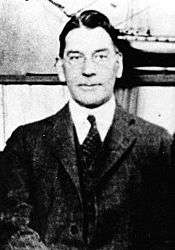1887 Navy Midshipmen football team
The 1887 Navy Midshipmen football team represented the United States Naval Academy during the 1887 college football season. The team compiled a 3–1 record and outscored its opponents 41 to 22.[1] The Midshipmen shut out their first three opponents, including an 8–0 victory in the seventh installment of the Johns Hopkins–Navy football rivalry.[2] The Johns Hopkins game was played at the Academy grounds in Annapolis, Maryland, and was described by The Sun (New York) as "a veritable slugging match" and "one of the roughest games of football" ever seen there.[3] In the final game of the 1887 season, the Midshipmen lost to the Princeton Tigers "B" team in the final game of the season. The team captain was George Hayward.[1][2]
| 1887 Navy Midshipmen football | |
|---|---|
| Conference | Independent |
| 1887 record | 3–1 |
| Head coach | None |
| Offensive scheme | Modified V-formation |
| Captain | George Hayward |
| Home stadium | Western King Field |
| 1887 Southern college football independents records | ||||||||||||||||||||||||||||||||||||||||||||||||||||||||||||||||||||||||||||||||||||||||||||||||||
|---|---|---|---|---|---|---|---|---|---|---|---|---|---|---|---|---|---|---|---|---|---|---|---|---|---|---|---|---|---|---|---|---|---|---|---|---|---|---|---|---|---|---|---|---|---|---|---|---|---|---|---|---|---|---|---|---|---|---|---|---|---|---|---|---|---|---|---|---|---|---|---|---|---|---|---|---|---|---|---|---|---|---|---|---|---|---|---|---|---|---|---|---|---|---|---|---|---|---|
| Conf | Overall | |||||||||||||||||||||||||||||||||||||||||||||||||||||||||||||||||||||||||||||||||||||||||||||||||
| Team | W | L | T | W | L | T | ||||||||||||||||||||||||||||||||||||||||||||||||||||||||||||||||||||||||||||||||||||||||||||
| Navy | – | 3 | – | 1 | – | 0 | ||||||||||||||||||||||||||||||||||||||||||||||||||||||||||||||||||||||||||||||||||||||||||||
| Georgetown | – | 2 | – | 1 | – | 0 | ||||||||||||||||||||||||||||||||||||||||||||||||||||||||||||||||||||||||||||||||||||||||||||
| Richmond | – | 1 | – | 1 | – | 0 | ||||||||||||||||||||||||||||||||||||||||||||||||||||||||||||||||||||||||||||||||||||||||||||
| Virginia | – | 0 | – | 0 | – | 1 | ||||||||||||||||||||||||||||||||||||||||||||||||||||||||||||||||||||||||||||||||||||||||||||
| Johns Hopkins | – | 0 | – | 2 | – | 0 | ||||||||||||||||||||||||||||||||||||||||||||||||||||||||||||||||||||||||||||||||||||||||||||
| Randolph–Macon | – | – | ||||||||||||||||||||||||||||||||||||||||||||||||||||||||||||||||||||||||||||||||||||||||||||||||
| St. John's (MD) | – | – | ||||||||||||||||||||||||||||||||||||||||||||||||||||||||||||||||||||||||||||||||||||||||||||||||
Prelude
The Naval Academy's football program formally began in 1879 with a game against the Baltimore Athletic Club. The program went on a two-year hiatus in 1880 and 1881 due to a lack of support, before it was brought back by Vaulx Carter.[4][5] Johns Hopkins was Navy's primary opponent during the 1880s; the annual contest between the programs made up the entirety of the academy's 1882 through 1884 seasons.[6]
Schedule
| Date | Opponent | Site | Result |
|---|---|---|---|
| November ? | St. John's (MD) |
| W 4–0 |
| November 12 | St. John's (MD) |
| W 24–0 |
| November 24 | Johns Hopkins |
| W 8–0 |
| November 26 | Princeton Reserves |
| L 22–5 |
Players
The 1887 Naval Academy football team was made up of twelve players at six unique positions. The squad consisted of five rushers, two ends, one snapback, one fullbacks, two halfbacks, and one quarterbacks. Four of the players (both halfbacks, the fullback, and a rusher) had played the previous season.[7] The age of the players ranged several years due to the academy's admission policy; the school allowed for men between the ages of 14 and 18 to be admitted, which future player John B. Patton remarked made it "just a boys' school".[8]
|
Rushers
|
 Curtis Dwight Wilbur, a rusher on the 1887 team, was later appointed Secretary of the Navy
Full-backs
|
|
References
Footnotes
- "Navy Yearly Results (1885-1889)". College Football Data Warehouse. David DeLassus. Retrieved July 12, 2015.
- "Football History" (PDF). United States Naval Academy. p. 188. Retrieved July 12, 2015.
- "Football at Annapolis". The Sun (New York). November 25, 1887.
- Bealle (1951), pp. 8–9
- Clary (1997), pp. 10–11
- Clary (1997), p. 13
- Bealle (1951), p. 14
- Schoor (1967), p. 5
Bibliography
- Bealle, Morris Allison (1951). Gangway for Navy: The Story of Football At United States Naval Academy, 1879–1950. Washington, D.C.: Columbia Publishing Company. OCLC 1667386.
- Clary, Jack (1997). "The Tradition Begins: 1879–1899". Navy Football: Gridiron Legends and Fighting Heroes. Annapolis, Maryland: Naval Institute Press. pp. 7–18. ISBN 978-1-55750-106-6. OCLC 36713133.
- Schoor, Gene (1967). "Football Comes to Annapolis and West Point". In Schoor, Gene (ed.). The Army–Navy Game: A Treasury of the Football Classic. New York City: Dodd, Mead and Company. pp. 3–9. OCLC 371756.